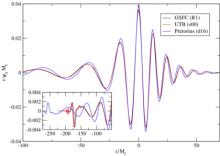
Abstract
This a particularly exciting time for gravitational wave physics. Ground-based gravitational wave detectors are now operating at a sensitivity such that gravitational radiation may soon be directly detected, and recently several groups have independently made significant breakthroughs that have finally enabled numerical relativists to solve the Einstein field equations for coalescing black-hole binaries, a key source of gravitational radiation. The numerical relativity community is now in the position to begin providing simulated merger waveforms for use by the data analysis community, and it is therefore very important that we provide ways to validate the results produced by various numerical approaches. Here, we present a simple comparison of the waveforms produced by two very different, but equally successful approaches--the generalized harmonic gauge and the moving puncture methods. We compare waveforms of equal-mass black hole mergers with minimal or vanishing spins. The results show exceptional agreement for the final burst of radiation, with some differences attributable to small spins on the black holes in one case.